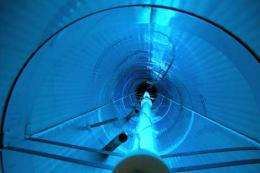Gases drawn into smog particles stay there, study reveals

Airborne gases get sucked into stubborn smog particles from which they cannot escape, according to findings by UC Irvine and other researchers published today in the Proceedings of the National Academy of Sciences.
The results could explain a problem identified in recent years: Computer models long used by the U.S. Environmental Protection Agency, California air regulators and others significantly underestimate organic aerosols – the major component of smog particles. Such pollution blocks views of mountains and has been linked to everything from asthma to heart attacks. It is also the largest unknown in climate change calculations.
"You can't have a lot of confidence in the predicted levels right now," said lead author Veronique Perraud, assistant project scientist to pioneering UCI air chemist Barbara Finlayson-Pitts. "It's extremely important, because if the models do a bad job of predicting particles, we may be underestimating the effects on the public."
An independent expert who reviewed the research for PNAS agreed.
"The conclusions are highly significant," said Purdue University atmospheric chemist Paul Shepson. "This paper should – and, I expect, will – have a big impact. We've known for nearly a decade that there's a huge difference between what's in the models and what's actually in the air. Thanks to this paper, we have a much better idea of why."
Scientists at UCI, a U.S. Department of Energy laboratory and Portland State University combined pinene, a common ingredient in household cleaners such as Pine Sol and outdoor emissions, with oxides of nitrogen and ozone to mimic smog buildup.
Models used by regulators for decades have assumed that organic aerosols in such pollution form liquid droplets that quickly dissolve potentially unhealthy gases. But the new work found that once gases are sucked into a particle, they get buried deeper and deeper.
"They check in, and they don't check out. They cannot escape. The material does not readily evaporate and may live longer and grow faster in total mass than previously thought," Finlayson-Pitts said. "This is consistent with related studies showing that smog particles may be an extremely viscous tar."
Perraud noted that broader study needs to be done: "The next logical step is to straighten the models out. We need enough follow-up data to do so."
Sophisticated tools made it easier to pinpoint the exact characteristics of chemical compounds in air. The scientists used a 26-foot-long "aerosol flow tube" at the AirUCI unit and a one-of-a-kind, 900-pound instrument known as SPLAT (a single particle laser ablation time-of-flight mass spectrometer) at the Pacific Northwest National Laboratory.
Journal information: Proceedings of the National Academy of Sciences
Provided by University of California - Irvine



















